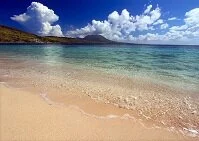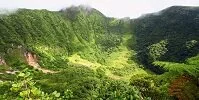Geography, Weather, & Wildlife of St. Kitts & Nevis
Geography

Beach
St. Kitts & Nevis is an island nation in the Caribbean Sea located in an island chain known as the Lesser Antilles, and more specifically the Leeward Islands. The nation has no land borders, but is close to a couple other nations. To the north is the British territory of Anguilla, to the east is Antigua & Barbuda, and to the south is the British territory of Montserrat. The Caribbean Sea is to St. Kitts & Nevis's west and the Atlantic Ocean is to the country's east.
Both the islands of St. Kitts and Nevis are volcanic mountainous islands. Due to this, the most livable parts of the islands are along the coasts of each island.
Weather

Mt. Liamuiga
St. Kitts & Nevis have a fairly regular weather pattern with only the hurricane season injecting any great variation. Year round the islands average about 75-80° F (24-27° C) with days getting a little hotter and nights a little cooler. The islands are relatively dry from a humidity stand point, except during the wet season, which is again very mild. Most rain falls from May to October and most of it falls in the mountains, although the islands are much drier than many other Caribbean islands. The greatest rains, winds, and storms arrive with hurricane season, which lasts from June to November, with the worst storms generally arriving later in that window.